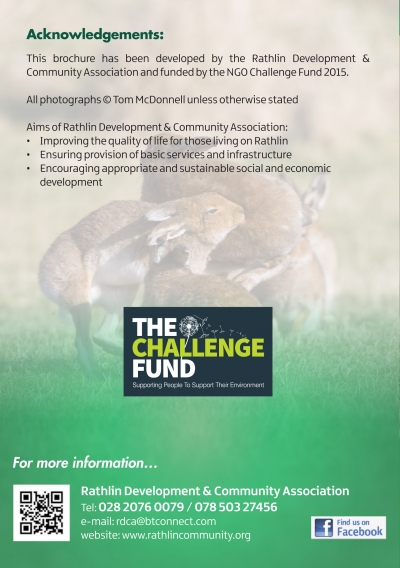The nature of Rathlin and its townlands
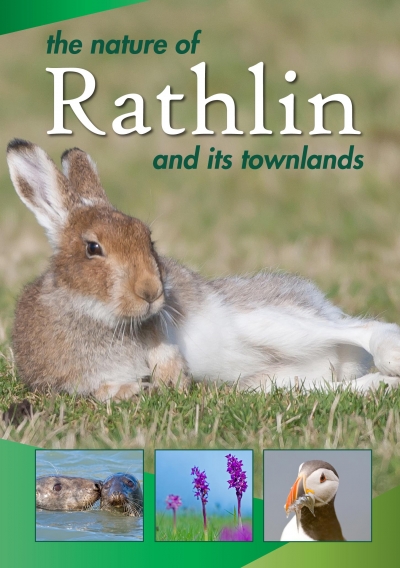
Introduction
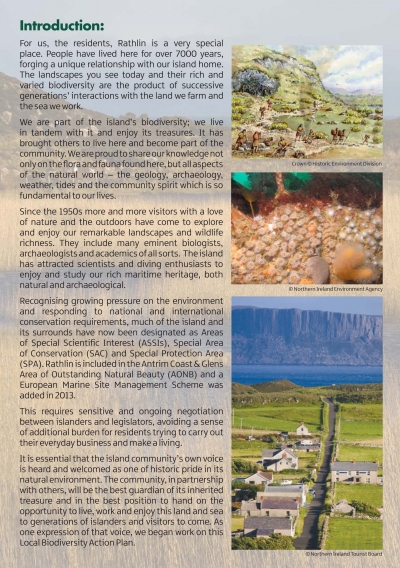
For us, the residents, Rathlin is a very special place. People have lived here for over 7,000 years, forging a unique relationship with our island home. The landscapes you see today and their rich and varied biodiversity are the product of successive generations' interaction with the land we farm and the sea we work.
We are part of the island's biodiversity; we live in tandem with it and enjoy its treasures. It has brought others to live here and become part of the community. We are proud to share our knowledge not only on the flora and fauna found here, but all aspects of the natural world - the geology, archeology, weather, tides and the community spirit which is so fundamental to our lives.
Since the 1950s more and more visitors with a love of nature and the outdoors have come to explore and enjoy our remarkable landscapes and wildlife richness. They include many eminent biologists, archeologists and academics of all sorts. The island has attracted scientists and diving enthusiasts to enjoy and study our rich maritime heritage, both natural and archeological.
Recognising growing pressure on the environment and responding to national and international conservation requirements, much of the island and its surrounds have now been designated as Areas of Special Scientific Interest (ASSIs), Special Area of Conservation (SAC) and Special Protection Area (SPA). Rathlin is included in the Antrim Coast & Glens Area of Outstanding Natural Beauty (AONB) and a European Marine Site Management Scheme (EMSMS) was added in 2013.
This requires sensitive and ongoing negotiation between islanders and legislators, avoiding a sense of additional burden for residents trying to carry out their everyday business and make a living.
It is essential that the island community's own voice is heard and welcomed as one of historic pride in its natural environment. The community, in partnership with others, will be the best guardian of its inherited treasure and in the best position to hand on the opportunity to live, work and enjoy this land and sea to generations of islanders and visitors to come. As one expression of that voice, we began work on this Local Biodiversity Action Plan.
What is a Local Biodiversity Action Plan?
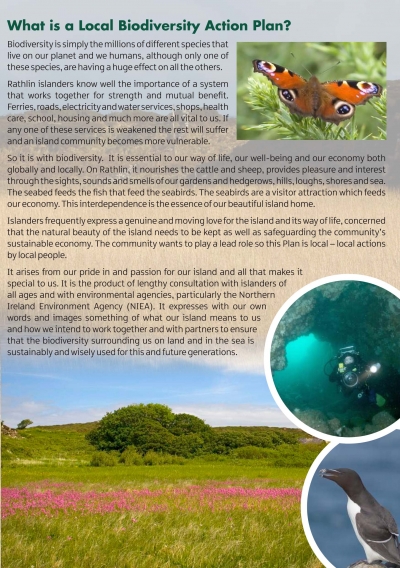
Biodiversity is simply the millions of different species that live on our planet and we humans, although only one of these species is having a huge effect on all the others.
Rathlin Islanders know well the importance of a system that works together for strength and mutual benefit. Ferries, roads, electricity and water services, shops, health care, school, housing and much more are all vital to us. If any one of these services is weakened the rest will suffer and an island community becomes more vulnerable.
So it is with biodiversity. It is essential to our way of life, our well-being and our economy both globally and locally. On Rathlin, it nourishes the cattle and sheep, provides pleasure and interest through the sights, sounds and smells of our gardens and hedgerows, hills, loughs, shores and sea. The seabed feeds the fish that feed the seabirds. The seabirds are a visitor attraction which feeds our economy. This interdependence is the essence of our beautiful island home.
Islanders frequently express a genuine and moving love for the island and its way of life, concerned that the natural beauty of the island needs to be kept as well as safeguarding the community's sustainable economy. The community wants to play a lead role so this Plan is local - local actions by local people.
It arises from our pride in and passion for our island and all that makes it special to us. It is the product of lengthy consultation with islanders of all ages and with environmental agencies, particularly the Northern Ireland Environment Agency (NIEA). It expresses with our own words and images something of what our island means to us and how we intend to work together and with partners to ensure that the biodiversity surrounding us on land and in the sea is sustainably and wisely used for this and future generations.
Rathlin's townlands and nature
A townland (in Irish: Baile Fearainn) is a distinctively Irish term for a small geographical division of land, and most have names of Gaelic origin. There are twenty two Rathlin townlands.
Part of the process of creating this Action Plan rested with the young children of St Mary's Primary School learning from the older members of our community. Together we created a jig-saw map of the island's traditional townlands. This gave us the opportunity for stimulating conversation between the island's children and the older residents on what each townland has to offer through the wide ranges of biodiversity. Each townland holds part of the rich heritage we are all responsible for keeping alive.
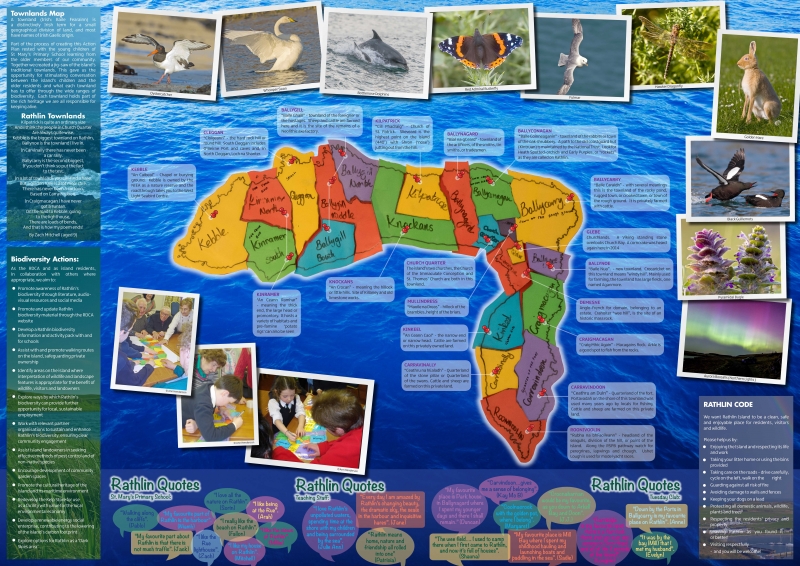
Rathlin's townland names are mostly of very old Irish origin, with prefixes such as 'bally' (baile in Irish) - meaning 'place of' - being as common as they are on the mainland. The exceptions are of English (Church Quarter) or Anglo-Norman (Glebe and Demesne) origin, reflecting their use by the then landowners.
Rathlin's townlands - click on the links to learn more about them:
Ballycarry
Ballyconagan
Ballygill Middle
Ballygill North
Ballygill South
Ballynagard
Ballynoe
Carravinally
Carravindoon
Church Quarter
Cleggan
Craigmacagan
Demesne
Glebe
Kebble
Kilpatrick
Kinkeel
Kinramer North
Kinramer South
Knockans
Mullindress
Roonivoolin
Rathlin Townlands by Zach Mitchell (age 9), pupil in St Mary's Primary School
Kilpatrick is quite an ordinary size
And I think the people in Church Quarter
Are always quite wise.
Kebble is the biggest townland on Rathlin,
Ballynoe is the townland I live in.
In Carvinally there has never been a car rally.
Ballycarry is the second biggest,
If you don't think so put the fact to the test.
In a lot of the townlands you can find a hare,
But a golden hare is a lot more rare.
There has never been a cartoon
Based on Carravindoon.
In Craigmacagan I have never got a suntan.
On the road to Kebble, going to the lighthouse,
There are loads of bends,
And that is how my poem ends!
Rathlin quotes - celebrating Rathlin's beautiful biodiversity:
St Mary's Primary School pupils:
"Walking along the cliffs" - Pablo
"My favourite part of Rathlin is the harbour" - Niamh
"I love all the nature on Rathlin" - Sórin
"I like being at the Rue" - Arah
"My favourite part is that there is not much traffic" - Jack
"I like the Rue lighthouse" - Zach
"I really like the beach on Rathlin" - Fallon
"I like my house on Rathlin" - Mitchell
"I like the views of Rathlin" - Millie
St Mary's Primary School staff:
"I love Rathlin's unpolluted waters, spending time at the shore with my children and being surrounded by the sea" - Julie Ann
"Every day I am amazed by Rathlin's changing beauty, the dramatic sky, the seals in the harbour and inquisitive hares" - Jane
"Rathlin means home, nature and friendship all rolled into one" - Patricia
The Tuesday Club:
"My favourite place is Park house in Ballynagard where I spent my younger days and where I shall remain" - Duncan
"Carravindoon... gives me a sense of belonging" - Kay McB
"Coolnagrock with the golden pot, where I belong" - Margaret
"Crocnaharnan would be my favourite, as you go down to Arkell Bay and Doon" - JJ
"The wee field... I used to camp there when I first came to Rathlin, and now it's full of houses" - Shauna
"My favourite place is Mill Bay where I spent my childhood hauling and launching boats and paddling in the sea" - Sadie
"Carriclyle is my favourite spot... there is a flat rock and you can see Torr Head and all of the Eastside of the Island" - Loughie
"Down by the Ports in Ballycarry is my favourite place on Rathlin" - Anne
"It was by Mill Bay that I met my husband" - Evelyn
Rathlin at work and play
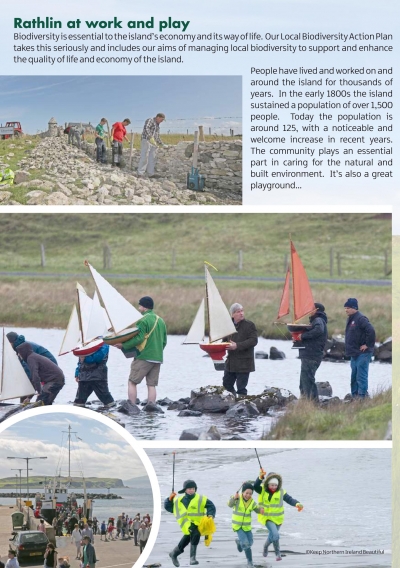
Biodiversity is essential to the island's economy and its way of life. Our local Biodiversity Action Plan takes this seriously and includes our aims of managing local biodiversity to support and enhance the quality of life and economy of the island.
People have lived and worked on and around the island for thousands of years. In the early 1800s Rathlin sustained a population of over 1,500 people. Today the population is around 140, with a noticeable and welcome increase in recent years. The community plays an essential part in caring for the natural and built environment. It's also a great playground...
Farming
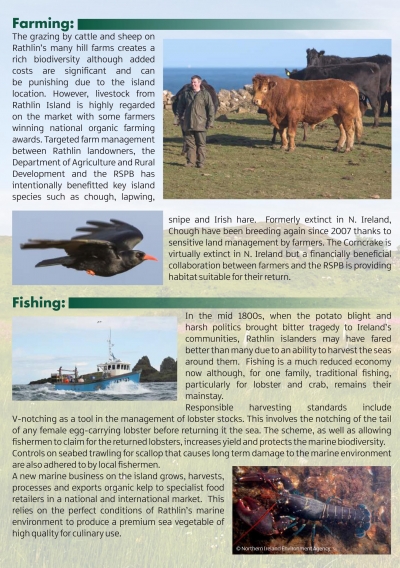
The grazing by cattle and sheep on Rathlin's many hill farms creates a rich biodiversity although added costs are significant and can be punishing due to the island location. However, livestock from Rathlin Island is highly regarded on the market with some farmers winning national organic farming awards. Targeted farm management between Rathlin landowners, the Department of Agriculture and Rural Development and the RSPB has intentionally benefitted key island species such as chough, lapwing, snipe and Irish hare. Formerly extinct in Northern Ireland, chough have been breeding again since 2007 thanks to sensitive land management by farmers. The corncrake is virtually extinct in Northern Ireland but a financially beneficial collaboration between farmers and the RSPB is providing habitat suitable for their return.
Fishing
In the mid 1800s, when the potato blight and harsh politics brought bitter tragedy to Ireland's communities, Rathlin Islanders may have fared better than many due to an ability to harvest the seas around them. Fishing is a much reduced economy now, although for one family traditional fishing, particularly for lobster and crab, remains their mainstay.
Responsible harvesting standards include V-notching as a tool in the management of lobster stocks. This involves the notching of the tail of any female egg-carrying lobster before returning it to the sea. The scheme, as well as allowing fishermen to claim for the returned lobsters, increases yield and protects marine biodiversity.
Controls on seabed trawling for scallop that causes long term damage to the marine environment are also adhered to by local fishermen.
A new marine business on the island grows, harvests, processes and exports organic kelp to specialist food retailers in a national and international market. This relies on the perfect conditions of Rathlin's marine environment to produce a premium sea vegetable of high quality for culinary use.
Tourism
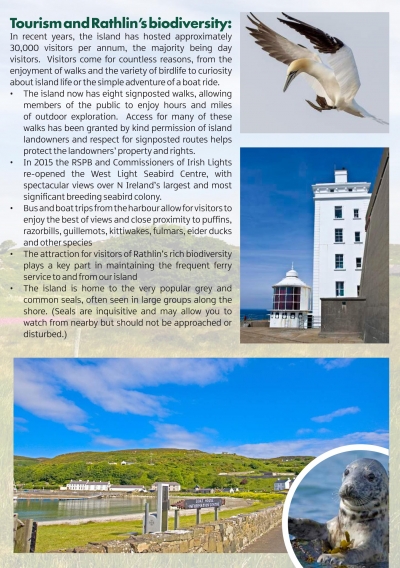
In recent years the island has hosted approximately 30,000 visitors per annum, the majority being day visitors. Visitors come for countless reasons, from the enjoyment of walks and the variety of birdlife to curiosity about island life or the simple adventure of a boat ride.
- The island now has eight signposted walks, allowing members of the public to enjoy hours and miles of outdoor exploration. Access for some of these walks has been granted by kind permission of island landowners and respect for signposted routes helps protect the landowners' property and rights.
- In 2015 the RSPB and the Commissioners of Irish Lights re-opened the West Light Seabird Centre, as part of the new Great Lighthouses of Ireland trail, with spectacular views over Northern Ireland's largest and most significant seabird breeding colony.
- Bus and boat trips from the harbour allow for visitors to enjoy the best of views and close proximity to puffins, razorbills, guillemots, kittiwakes, fulmars, eider ducks and other species.
- The attraction for visitors of Rathlin's rich biodiversity plays a key part in maintaining the frequent ferry service to and from our island.
- The island is home to the very popular grey seals and common (or harbour) seals, often seen in large groups along the shore. (Seals are inquisitive and may allow you to watch from quite nearby, but should not be approached or disturbed.)
Working in partnership
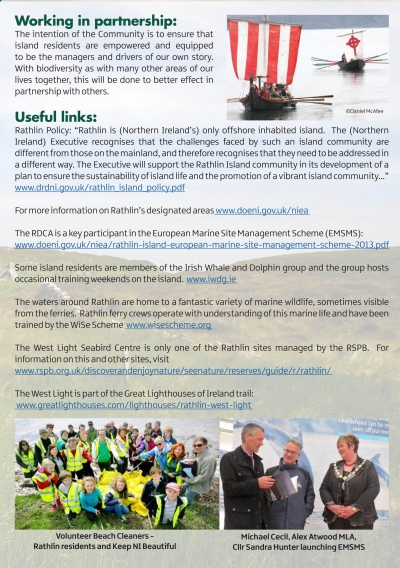
The intention of the Rathlin community is to ensure that island residents are equipped to be the managers and drivers of our own story. With biodiversity as with many other areas of our lives together, this will be done to better effect in partnership with others.
Gallery
A gallery of some of the fantastic photos demonstrating Rathlin's special biodiversity is available here.
Biodiversity actions
As the RDCA and as island residents, in collaboration with others where appropriate, we aim to:
- Promote awareness of Rathlin's biodiversity through literature, audio-visual resources and social media
- Promote and update Rathlin biodiversity material through the RDCA website
- Develop a Rathlin biodiversity information and activity pack with and for schools
- Assist with and promote walking routes on the island, safeguarding private ownership
- Identify areas on the island where interpretation of wildlife and landscape features is appropriate for the benefit of wildlife, visitors and landowners
- Explore ways by which Rathlin's biodiversity can provide further opportunity for local, sustainable employment
- Work with relevant partner organisations to sustain and enhance Rathlin's biodiversity, ensuring clear community engagement
- Assist island landowners in seeking effective methods of pest control and control of non-native species
- Encourage development of community garden species
- Promote the cultural heritage of the island and its maritime environment
- Redevelop the Kelp Store for use as a facility with value for the local environmental economy
- Develop a renewable energy social enterprise, contributing to the lowering of the island's carbon footprint
- Explore options for Rathlin as a 'Dark Skies' area.
The Rathlin Code
The Rathlin Development & Community Association has drawn up a code to encourage visitors and residents to be able to have a clean, safe and enjoyable experience of Rathlin Island.
The code is intended to ensure that some of the issues that have caused concern in the past will be addressed, and that island residents and visitors alike can have as enjoyable an experience as possible, during the tourist season and year round as well:
We want Rathlin Island to be a clean, safe and enjoyable place for residents, visitors and wildlife.
- Please help us by:
- Enjoying the Island and respecting its life and work
- Taking your litter home or using the bins provided
- Taking care on the roads - drive carefully, cycle on the left, walk on the right
- Guarding against all risk of fire
- Avoiding damage to walls and fences
- Keeping your dogs on a lead
- Protecting all domestic animals, wildlife, plants and trees
- Respecting the residents’ privacy and property
- Leaving Rathlin as you found it – or better!
- Visiting respectfully
- - and you will be welcome!
Social media
As part of this Biodiversity Action Plan, we would like to encourage people - Rathlin residents and our many visitors - to share their experiences, thoughts and photographs of Rathlin's amazing flora and fauna. Please visit the RDCA's Facebook page, maybe join the Friends and Residents of Rathlin Facebook group, or check out the new Nature of Rathlin Twitter page, and help share the special beauty of Rathlin's biodiversity (and don't forget to use #natureofrathlin)!
Links
The Stormont Executive's Rathlin Policy: "Rathlin is [Northern Ireland's] only offshore inhabited island. The [Northern Ireland] Executive recognises that the challenges faced by such an island community are different from those on the mainland, and therefore recognises that they need to be addressed in a different way. The Executive will support the Rathlin Island community in its development of a plan to ensure the sustainability of island life and the promotion of a vibrant island community."
The Department of the Environment Northern Ireland's page on Rathlin's Areas of Special Scientific Interest.
The RDCA is a key participant in the European Marine Site Management Scheme.
Some island residents are members of the Irish Whale and Dolphin Group and the Group hosts occasional training weekends on the island.
The waters around Rathlin are home to a fantastic variety of marine wildlife, sometimes visible from the ferries. Rathlin ferry crews operate with the understanding of this marine life and have been trained by the WiSe Scheme.
‘Rathlin Island: An Archaeological Survey of a Maritime Landscape’ edited by Wes Forsythe and Rosemary McConkey.
'Rathlin: Nature and Folklore' by Philip Watson.
The RSPB Seabird Centre at the West Light.
The Great Lighthouses of Ireland page on Rathlin's West Light.
Wikipedia entry on the UK's Biodiversity Action Plan.
The UK government's biodiversity policy.
The Department of the Environment Northern Ireland's page on biodiversity.
Biodiversity Northern Ireland's main page, section on local council area, and page on Rathlin's Kebble Nature Reserve.
Causeway Coast & Glens Borough Council's biodiversity policy.
